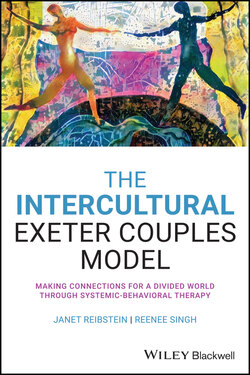Читать книгу The Intercultural Exeter Couples Model - Reenee Singh - Страница 10
THE CULTURAL GENOGRAM: A KEY INTERVENTION
ОглавлениеThe cultural genogram (Hardy & Laszloffy, 1995) enquires about the cultural, ethnic, and religious heritages of the people explicitly within the genogram. Within intercultural work, this is “best practice” intervention and as such it has become a key intervention within the IEM.
The cultural genogram is a method to expand the couple's stories and ability to question their often unspoken differing and potentially conflictual cultural practices and beliefs. Via cultural genograms partners can discuss their cultural backgrounds, recount beliefs carried by family members in generations past, and convey their feelings regarding family rituals and legacies. Genograms are also an opportunity to bring into view contradictions among historical narratives originating both in each partner's family of origin and in the larger society (i.e., what is discussed and what has been omitted, and by whom and for what purposes). Specific family themes, such as heterogamous relationships, cultural ancestry, and the circumstances under which partners' ancestors entered the country can be coded with colors and/or symbols that carry meaning for each partner. Family photographs, cultural artifacts, and recreating a cultural ritual in the therapy room can add to the experience (Hardy & Laszloffy, 1995; Singh, Killian, Bhugun, & Tseng, 2020).
The cultural genogram can be used in conjunction with the EM method of tracking the maintenance cycle of the interacting circularities: the thoughts and feelings part of which may well be informed by these differing yet unspoken beliefs and assumed practices. Vicious cycles have the possibilities to become virtuous cycles: adding in explicitly the intercultural dimension can unearth deeply held ideas and expectations that can block this process if not made clear.
The method for doing this is the cultural genogram, an illustration of which will appear in the second part of this book.
